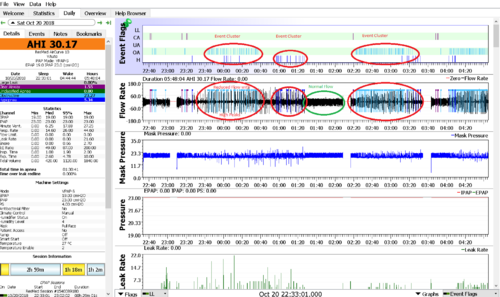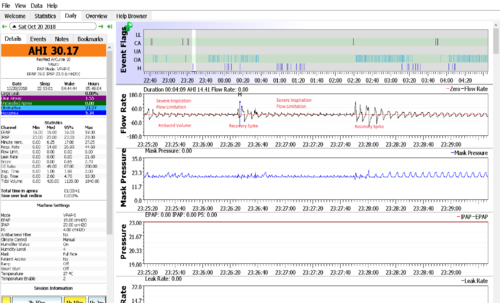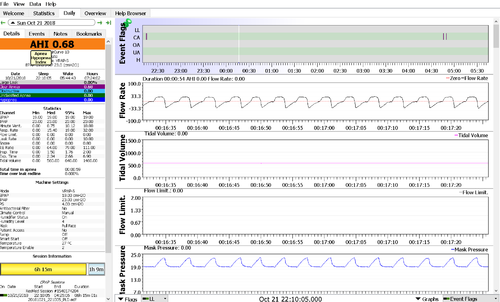Difference between revisions of "Alternate Therapy for Apnea"
(→Myofunctional Therapy (excercise)) |
(→Myofunctional Therapy (excercise)) |
||
| Line 220: | Line 220: | ||
Search for "myofunctional therapy exercises for sleep apnea" to find excercises | Search for "myofunctional therapy exercises for sleep apnea" to find excercises | ||
| + | |||
| + | == Medications == | ||
| + | |||
| + | |||
| + | "The use of zolpidem (Ambien) and triazolam (Halcion) may be considered for the treatment of primary central sleep apnea syndromes only if the patient does not have underlying risk factors for respiratory depression. (Option.) There is limited available evidence for this recommendation. Use of these medications may produce adverse effects, such as respiratory depression, and should be considered only as a last therapeutic option if other options are unsuccessful. Close clinical follow-up is required for patients using these hypnotic agents." | ||
| + | |||
| + | - https://www.aafp.org/afp/2012/1115/p968.html | ||
Revision as of 14:50, 22 July 2019
Note: I have just started gathering information This article is nowhere near ready for public consumption but feel free to grab info where you need to.
Contents
General Info
https://www.sleepassociation.org/sleep-treatments/cpap-machines-masks/cpap-alternatives/
https://www.eossleep.com/2015/12/28/6-cpap-alternatives-that-will-actually-make-your-life-better/
CPAP Issues Side Effects or Problems
- Frequent nocturnal awakenings
- Fatigue and Sleepiness
- some patients have persistent sleepiness despite good adherence to CPAP
- Symptoms are usually eliminated as soon as CPAP therapy is started
- Studies have shown that the maximum effect of CPAP therapy occurs in about 2 weeks
- Still Sleepy on CPAP after a month
- Increase the CPAP Pressure (IPAP)
- Set (increase) inhale pressure (IPAP) to resolve snoring and hypopnea
- Set (decrease) exhale pressure (IPAP - EPR (or Flex)) to resolve obstructive apnea
- Consider change to AutoPAP at set range to determine best pressure
- Consider changing to BPAP/BiLevel
- Set (increase) inhale pressure (IPAP) to resolve snoring and hypopnea
- Set (decrease) exhale pressure (EPAP) to resolve Obstructive apnea
- Increase the CPAP Pressure (IPAP)
- Nasal congestion
- Treat nasal congestion with heated humidification and/or nasal medications
- Nasal irritation/Dryness
- Nasal symptoms frequently respond to heated humidification of the CPAP air
- Mouth Dryness (Mouth Breathing)
- See Mask Primer
- Puffing/Mouth Breathing
- See Mask Primer
- Leaking
- See Mask Primer
- Claustrophobia
- Desensitize, Start with short periods of time while awake and engaged in a distraction like watching TV or reading. Increase the time each session.
- Snoring
- Set (increase) inhale pressure (IPAP) to resolve snoring and hypopnea
- Aerophagia is a condition that occurs when a person swallows too much air. The air goes into the stomach and intestines causing abdominal bloating, belching, flatulence, discomfort and pain
- See Aerophagia Wiki Article
- The condition usually subsides on its own as patients adapt to the CPAP therapy
- Lower CPAP Pressure
- Switch to a BiPAP/BiLevel machine
- Flatulence
- See Aerophagia Wiki Article
- Other sleep disorders
AAST American Association of Sleep Technologists The International Palestinian Congress in Sleep Medicine Presentation A slide presentation titled Using PAP Downloads to Manage Sleep Apnea Patients
Original link "Using PAP Downloads to Manage Sleep Apnea Patients"
CPAP
Standard Therapy
Inspire
Inspiresleep Manufacturer site
Studies published in major scientific journals, including the New England Journal of Medicine, showed that 2 out of 3 patients who received the Upper Airway Stimulation system achieved a dramatic improvement or resolution of their sleep apnea. This means 1 out of 3 did not achieve satisfactory results. Of the 2/3 that did, the percentage that resolved/eliminated there apnea are not stated, which means that a percentagadditional success likely requires addition treatment.
Most of the procedure reviews are positive so it definitely works for some, but very few if any negative reviews, likely because the positive reviews are mostly on sites that sell the service.
Check out Inspire therapy.
"Inspire therapy is a breakthrough implantable treatment option for people with Obstructive Sleep Apnea who are unable to use or get consistent benefit from Continuous Positive Airway Pressure (CPAP). While you’re sleeping, Inspire monitors every breath you take. Based on your unique breathing patterns, the system delivers mild stimulation to the hypoglossal nerve which controls the movement of your tongue and other key airway muscles. By stimulating these muscles, the airway remains open during sleep.
The Inspire obstructive sleep apnea device is controlled by a small handheld sleep remote. The remote allows you to turn Inspire therapy on before bed and off when you wake up, increase and decrease stimulation strength, and pause during the night if needed."
Its kind of like a pace maker for OSA. Seems bizarre, however another solution for you to research!!
Think it ok to post this link: https://www.inspiresleep.com/
forum first-steps-for-inspire-therapy-coming-up
from Post #16 Actually it cost about $40,000 for me. My insurance paid it 100%. I had already met my deductible and I literally paid $0.00 for this surgery. I called the insurance company and lobbied for it. They had ever paid for it and they made a few calls and it was agreed to. Normally I hear it takes 6-8 weeks for insurance approval but my time was a lot shorter.
My summary of the surgery is that it saved my life. Yes it is invasive. Three 3 inch incisions. Implanted device near the collarbone and one under the jaw and one in my right chest. Total time out of work was 3.5 days. Waited 1 month until they turned it on after surgery and my sleep apnea is almost 100% gone. The stimulation that it does is uncomfortable but is not painful, really just a bit weird feeling. I now get a good solid 6-7 hours of sleep each night. I no longer feel like a walking zombie.
The only maintenance with the unit is to carry the remote with me when I travel and to turn it on and off when I go to sleep and when I get up.
The battery is supposed to last ~10 years. I am 56 years old and assuming that I have it replaced when I am 65-66 I suspect the technology will have improved by then and it will last double that amount and that will be it for me.
It may not be for everyone, for sure, but for me (tried every type of Pap therapy and none were tolerable) it is a real lifesaver. My surgery was at University Hospital in Cleveland Ohio.
Sleeprider 11/12/16
http://www.apneaboard.com/forums/Thread-Info-on-INSPIRE
This is the first I have heard of it. The results of the Stimulation Therapy for Apnea Reduction (STAR) clinical trial look very good. This was a three year trial, and key findings are that the improvements observed at one-year were sustained at the three-year follow up mark. The outcomes include:
- A 78% reduction in apnea-hypopnea index (AHI) from baseline
- An 80% reduction in oxygen desaturation events from baseline
- 80% of bed partners reported soft or no snoring as compared to 17% of bed partners at baseline
- Quality of life measures, including daytime sleepiness and functioning, showed clinically meaningful improvements and a return to normal levels over baseline
Abstract is here: http://journals.sagepub.com/doi/abs/10.1177/0194599815616618
It's not perfect, and not recommended for those that tolerate CPAP therapy, but for sleep apnea patients with moderate or severe obstructive sleep apnea, and intolerance or poor efficacy for CPAP, it looks pretty good.
http://sleep-doctor.com/blog/upper-airway-stimulation-expensive-but-worth-it/
Surgery
CHOOSING THE RIGHT SURGERY FOR SNORING AND SLEEP APNEA
http://sleep-doctor.com/surgical-treatment-overview/choosing-right-surgery-snoring-sleep-apnea/
- Surgical Treatment Overview
- Choosing the Right Surgery
- DRUG-INDUCED SLEEP ENDOSCOPY
- NASAL PROCEDURES
- PLASTY & NASAL VALVE SURGERY
- SEPTOPLASTY
- SINUS SURGERY
- TURBINATE SURGERY
- PALATE PROCEDURES
- EXPANSION SPHINCTER PHARYNGOPLASTY
- LATERAL PHARYNGOPLASTY
- PALATE RADIOFREQUENCY
- PALATE SURGERY
- PILLAR PROCEDURE
- UVULOPALATOPLASTY (CAUTERY-ASSISTED)
- TONGUE REGION PROCEDURES
- EPIGLOTTIS SURGERY
- GENIOGLOSSUS ADVANCEMENT
- HYOID SUSPENSION
- LINGUAL TONSILLECTOMY
- MIDLINE GLOSSECTOMY AND SUBMUCOSAL LINGUALPLASTY
- TONGUE RADIOFREQUENCY
- INSPIRE UPPER AIRWAY STIMULATION
- MAXILLOMANDIBULAR ADVANCEMENT
MAD
Nasal Stent
Most of the current articles recognize CPAP as the preferred treatment for OSA but state that this may be an alternative for individuals that cannot tolerate CPAP. These are not OTC and require a prescription from a doctor.
Pilot Study of a Nasal Airway Stent for the Treatment on Obstructive Sleep Apnea Abstract Study background: Obstructive sleep apnea (OSA) is a common disease characterized by repetitive upper airway obstruction during sleep. OSA is associated with an increased risk of cardiovascular morbidity. Continuous positive airway pressure (CPAP) has been established as a standard therapy for OSA, but it is not always tolerated by OSA patients. Objective: In a pilot study, we evaluated the therapeutic effects of the nasal airway stent (NAS), a new nasopharyngeal device placed in the nasopharynx, on OSA and snoring. Methods: Six subjects with OSA were enrolled. The apnea-hypopnea index, oxygen desaturation index, lowest oxygen saturation, and snore index were analyzed before and during treatment with the NAS. Results: All subjects tolerated the NAS, with good compliance. Treatment with the NAS ameliorated apnea and hypopnea events and improved oxygen saturation in subjects with mild to moderate OSA. Snoring in all subjects was improved by the NAS. Conclusions: The NAS stent is a readymade device that could be an alternative therapy for patients with mild to moderate OSA who cannot tolerate CPAP or for subjects with snoring.
The AlaxoStent is a medical device for treatment of obstructive sleep apnea (OSA) and snoring that the patient can insert into his nose and throat at night and remove in the morning.
Complementing conventional therapy of OSA the AlaxoStent offers a new non-surgical and therapeutically efficient treatment which provides numerous advantages in handling and increased convenience to the patients.
Once the Stent is inserted it self-expands and attaches to the wall of the throat. Thereby, the stent prevents the collapse of the airway by mechanically splinting the throat.
| - | without therapy | with AlaxoStent | with CPAP |
|---|---|---|---|
| AHI | 31/h | 19/h | 8.2/h |
| obstructive apneas | 43.0 | 2.2 | 2.5 |
| minimal oxygen saturation | 79% | 84% | 89% |
Table 1: Results from the first clinical study (average values)
Other articles:
The Efficacy Of Nasal Airway Stent (nastent) On Obstructive Sleep Apnea And Prediction Of Treatment Outcomes ncbi.nlm.nih.gov/pubmed/30281824
Positional Apnea
Positional Apnea is caused by misalignment of the airway typically tucking the chin down. Excellent treatment is a loose fitting cervical collar to prevent chin tucking. It is normally detected by clusters of Obstructive and Hypopnea events usually associated with an uneven and smaller/narrower flow chart. Also see Flow Limitation[[1]]
With Soft Cervical Collar
Starting in 2016 we started seeing CPAP users using a loose fitting soft cervical collar to manage Mouth Breathing. Additionally, it was noted to resolve Position Apnea.
Enhanced Expiratory Rebreathing Space (EERS)
Enhanced Expiratory Rebreathing Space (EERS) This is an option for the treatment of therapy onset Central Apnea with CPAP This is a much less expensive option than getting an ASV machine. EERS is discussed in this wiki with contact information to the doctor and DME researching this option. EERS works by maintaining enough carbon dioxide in the breathing circuit to prevent central apnea. Please feel free to show your doctor this information and request that he consult with Dr. RJThomas, or prescribe an EERS mask from the DME.
Myofunctional Therapy (excercise)
Therapy (MT) to Treat Obstructive Sleep Apnea: A Systematic Review and Meta-analysis
Conclusion:
Current literature demonstrates that myofunctional therapy decreases the apnea-hypopnea index by approximately 50% in adults and 62% in children. Lowest oxygen saturations, snoring, and sleepiness outcomes improve in adults. Myofunctional therapy could serve as an adjunct to other obstructive sleep apnea treatments.
MT is composed of isotonic and isometric exercises that target oral (lip, tongue) and oropharyngeal structures (soft palate, lateral pharyngeal wall). There have been an increasing number of studies evaluating the effect of MT in the form of case studies, case series, and most recently, two randomized controlled trials.
Search for "myofunctional therapy exercises for sleep apnea" to find excercises
Medications
"The use of zolpidem (Ambien) and triazolam (Halcion) may be considered for the treatment of primary central sleep apnea syndromes only if the patient does not have underlying risk factors for respiratory depression. (Option.) There is limited available evidence for this recommendation. Use of these medications may produce adverse effects, such as respiratory depression, and should be considered only as a last therapeutic option if other options are unsuccessful. Close clinical follow-up is required for patients using these hypnotic agents."
- https://www.aafp.org/afp/2012/1115/p968.html

Donate to Apnea Board



